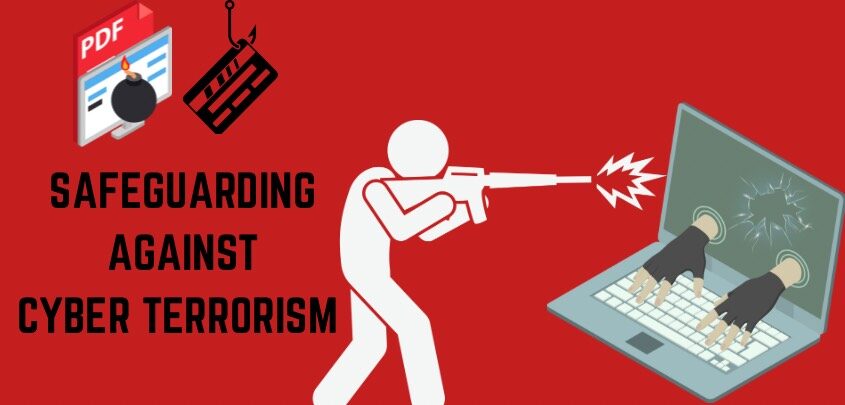
21, May, 2024
Cyber Terrorism: Threats, Tactics and Countermeasures
On this Anti-Terrorism Day, we aim to raise awareness about cyber terrorism, which poses a significant threat to individuals, organizations, and nations in today’s interconnected world. Understanding the nature of these threats, the tactics employed by cyber terrorists, and the countermeasures available is crucial in safeguarding our digital infrastructure.
What is Cyber Terrorism?
Cyber terrorism, also termed digital terrorism, refers to disruptive assaults carried out by recognized terrorist groups targeting computer systems. The aim is to create alarm, panic, or physically disrupt the information system. While we’re accustomed to hearing about cyber attacks, cyber terrorism brings a distinct level of concern. Historically, hackers sought classified information for financial motives, a tactic terrorists could emulate. Terrorists leverage the internet for financing, training, and planning attacks. A common aspect of cyber terrorism involves hacking into government or private servers to obtain sensitive data or funnel funds for terrorist purposes. Notably, there’s no universally agreed-upon definition of cyber terrorism .
Examples include-
▪Introducing viruses into susceptible data networks.
▪Breaching servers to disrupt communication and pilfer sensitive data.
▪Defacing websites, rendering them inaccessible to the public, leading to inconvenience and financial repercussions.
▪Hacking communication platforms to intercept or halt communications and issue terror threats online.
▪Targeting financial institutions to transfer funds and instill terror.
Threat Landscape
Due to its lack of physical violence targeting innocent individuals, cyber terrorism often goes unnoticed by many, who may not fully grasp its potential dangers.
As society increasingly relies on online services for cost reduction and efficiency improvement, coupled with ongoing advancements in cyberspace, there are more avenues for IT systems to face compromises.
Cyber terrorism involves various malicious activities leveraging digital technology to disrupt, damage, or instill fear. These threats are constantly evolving, targeting critical infrastructure, financial systems, government networks, and personal privacy and safety. From jeopardizing essential infrastructure like power grids and transportation to engaging in financial crimes such as theft, fraud, and extortion, cyber terrorism poses risks to governments, military organizations, healthcare facilities, and everyday individuals. The interconnected nature of modern systems amplifies the impact of these attacks, making them a significant global concern.
Tactics Used by Cyber Terrorists:
Cyber terrorists utilize various tactics to achieve their malicious objectives:
Phishing and Social Engineering:Phishing emails, fraudulent websites, and tactics involving social engineering aim to deceive individuals into sharing sensitive information like passwords, credit card details, or login credentials. These methods capitalize on human susceptibilities rather than exploiting technical vulnerabilities.
Denial-of-Service (DoS) Attacks:DoS attacks flood targeted systems with excessive traffic, overwhelming their capacity and causing service disruptions. Distributed Denial-of-Service (DDoS) attacks amplify the impact by coordinating multiple sources to bombard a target simultaneously.
Malware Attacks:Cyber terrorists utilize a range of malware types such as viruses, worms, trojans, and ransomware. These malicious software can infiltrate systems, exfiltrate sensitive data, disrupt functionality, or encrypt files, demanding ransom payments to restore access through decryption.
Advanced Persistent Threats (APTs):APTs are sophisticated and stealthy attacks that persistently target specific entities, such as government agencies or large corporations. They often involve reconnaissance, infiltration, data exfiltration, and long-term espionage.
Phishing and Social Engineering:Phishing emails, fake websites, and social engineering tactics are used to trick individuals into divulging confidential information such as passwords, credit card details, or access credentials. These tactics exploit human vulnerabilities rather than technical weaknesses.
Ransomware: This increasingly prevalent tactic involves encrypting files or locking systems, making them inaccessible to legitimate users. Cyber terrorists demand ransom payments, usually in cryptocurrencies, in exchange for decryption keys or unlocking the affected systems.
Countermeasures Against Cyber Terrorism:
Effective countermeasures can mitigate the impact of cyberterrorism:
Cybersecurity Awareness and Training:Educating individuals and organizations about cyber threats, safe online practices, and recognizing phishing attempts can significantly reduce the success rate of cyberattacks.
Regular Software Updates and Patch Management:Regularly updating operating systems, applications, and firmware with security patches and updates is crucial in addressing known vulnerabilities that cyberterrorists could exploit.
Incident Response Planning and Drills:Creating and routinely testing incident response plans guarantees a prompt and organized reaction to cyber incidents, reducing their impact and recovery duration.
Network Segmentation and Monitoring:Segmenting networks and monitoring traffic for irregularities aids in early detection and mitigation of potential threats.
Strong Authentication Mechanisms:Implementing multi-factor authentication (MFA), biometric authentication, and strong password policies adds layers of security against unauthorized access.
Collaboration and Information Sharing:Collaborating on threat intelligence, best practices, and security insights with industry peers, government bodies, and cybersecurity organizations strengthens collective defense mechanisms against cyberterrorism.
Highlighting few real life examples of cyber terrorism incidents in India:
1.Indian Banks Targeted by Cyber Attacks-In 2016 and 2017, several major Indian banks faced cyber attacks, including the infamous WannaCry ransomware attack. These attacks disrupted banking services, highlighting the vulnerability of financial institutions to cyber threats.
2.Phishing and Social Engineering-Indian individuals and entities frequently become targets of phishing schemes and social engineering strategies. For example, during 2021, there was a rise in phishing attacks related to COVID-19 specifically aimed at Indians. These attacks capitalized on pandemic-related fears and misinformation.
3.Critical Infrastructure Targeted-Cyber terrorists have aimed at India’s critical infrastructure, such as power grids and government networks. In 2020, the Maharashtra State Electricity Distribution Company Limited (MSEDCL) disclosed cyber attacks designed to disrupt power distribution in Mumbai.
Remaining watchful, establishing strong cybersecurity protocols, and promoting collaboration among stakeholders are key to strengthening our ability to withstand cyber terrorism threats and protect our digital landscape. By incorporating a comprehensive cybersecurity approach, embracing proactive defense tactics, and cultivating a culture of cyber resilience, both organizations and individuals can effectively reduce the vulnerabilities associated with cyber terrorism.
